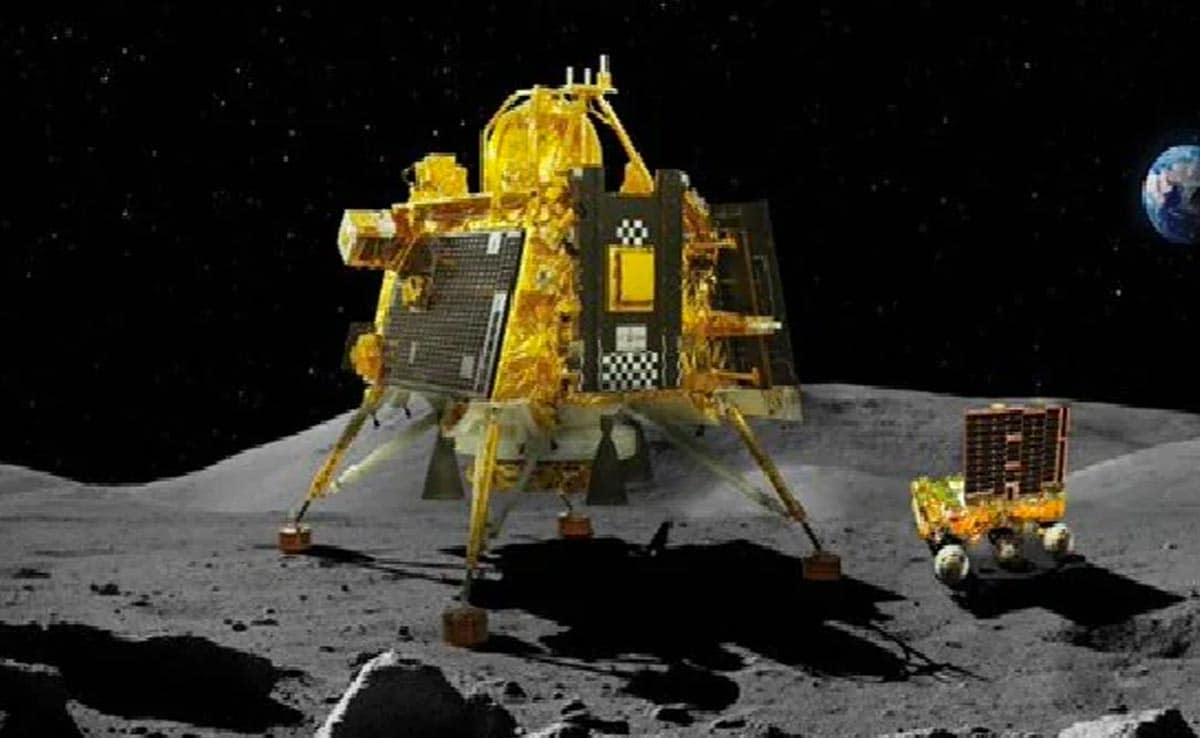Chandrayaan-3 is a follow-on mission to Chandrayaan-2 to exhibit start to finish capacity in safe landing and wandering on the lunar surface. It comprises of Lander and Meanderer arrangement. It will be sent off by LVM3 from SDSC SHAR, Sriharikota. The lander and rover will be carried by the propulsion module into a 100-kilometer lunar orbit. The Spectro-polarimetry of Habitable Planet Earth (SHAPE) payload in the propulsion module is used to investigate Earth’s spectral and polarimetric measurements from the lunar orbit.
Lander payloads: Temperature and thermal conductivity can be measured with Chandra’s Surface Thermophysical Experiment (ChaSTE); Instrument for Lunar Seismic Movement (ILSA) for estimating the seismicity around the arrival site; Plasma density and its variations can be estimated using the Langmuir Probe (LP). For research on lunar laser ranging, NASA has provided a passive Laser Retroreflector Array.
Payloads for the rover: Alpha Molecule X-beam Spectrometer (APXS) and Laser Prompted Breakdown Spectroscope (LIBS) for determining the basic organization nearby landing site.
Chandrayaan-3 comprises of a native Lander module (LM), Drive module (PM) and a Wanderer with a goal of creating and exhibiting new innovations expected for Entomb planetary missions. The Lander will have the capacity to delicate land at a predefined lunar site and convey the Wanderer which will do in-situ compound examination of the lunar surface over the span of its portability. Scientific payloads enable the Lander and the Rover to carry out experiments on the lunar surface. The principal capability of PM is to convey the LM from send off vehicle infusion till last lunar 100 km roundabout polar circle and separate the LM from PM. In addition, the Propulsion Module carries a single scientific payload as a value addition that will be utilized following the Lander Module’s separation. The launcher that has been identified for Chandrayaan-3 is GSLV-Mk3, and it will place the integrated module in an Elliptic Parking Orbit (EPO) that is approximately 170 x 36500 kilometers in size.
Chandrayaan-3’s mission goals are to perform in-situ scientific experiments, demonstrate Rover roving on the moon, and demonstrate safe and soft landing on the lunar surface.
~To accomplish the mission targets, a few cutting edge innovations are available in Lander, for example,
Altimeters: Laser and RF based Altimeters
Velocimeters: Horizontal Velocity Camera, Laser Doppler Velocimeter, and Lander Inertial Measurement: Propulsion System with an accelerometer and laser gyroscope package: Throttleable Engine Control Electronics, 800N Throttleable Liquid Engines, 58N Attitude Thrusters Navigation, Guidance, and Control (NGC): Hazard Detection and Avoidance: Powered Descent Trajectory Design and Related Software Elements Lander Risk Discovery and Evasion Camera and Handling Calculation
Landing Leg Instrument.
To exhibit the above said trend setting innovations in earth condition, a few Lander extraordinary tests have been arranged and done effectively viz.
Coordinated Cold Test – For the showing of Incorporated Sensors and Route execution test involving helicopter as test stage
Incorporated Hot test – For the showing of shut circle execution test with sensors, actuators and NGC utilizing Pinnacle crane as test stage
Lander Leg instrument execution test on a lunar simulant proving ground reproducing different touch down conditions.
The overall specifications for Chandrayaan-3 is provided below:-
Parameters & Specifications:-
1) Mission Life (Lander & Rover) One lunar day (~14 Earth days)
2) Landing Site (Prime) 4 km x 2.4 km 69.367621 S, 32.348126 E
3) Science Payloads
Lander:
Radio Anatomy of Moon Bound Hypersensitive ionosphere and Atmosphere (RAMBHA)
Chandra’s Surface Thermo physical Experiment (ChaSTE)
Instrument for Lunar Seismic Activity (ILSA)
Laser Retroreflector Array (LRA) Rover:
Alpha Particle X-Ray Spectrometer (APXS)
Laser Induced Breakdown Spectroscope (LIBS) Propulsion Module:
Spectro-polarimetry of HAbitable Planet Earth (SHAPE)
4. Two Module Configuration
Propulsion Module (Carries Lander from launch injection to Lunar orbit)
Lander Module (Rover is accommodated inside the Lander)
5. Mass
Propulsion Module: 2148 kg
Lander Module: 1752 kg including Rover of 26 kg
Total: 3900 kg
6. Power generation
Propulsion Module: 758 W
Lander Module: 738W, WS with Bias
Rover: 50W
7. Communication
Propulsion Module: Communicates with IDSN
Lander Module: Communicates with IDSN and Rover. Chandrayaan-2 Orbiter is also planned for contingency link.
Rover: Communicates only with Lander.
8. Lander Sensors
Laser Inertial Referencing and Accelerometer Package (LIRAP)
Ka-Band Altimeter (KaRA)
Lander Position Detection Camera (LPDC)
LHDAC (Lander Hazard Detection & Avoidance Camera)
Laser Altimeter (LASA)
Laser Doppler Velocimeter (LDV)
Lander Horizontal Velocity Camera (LHVC)
Micro Star sensor
Inclinometer & Touchdown sensors
9. Lander Actuators Reaction wheels – 4 nos (10 Nms & 0.1 Nm)
10. Lander Propulsion System Bi-Propellant Propulsion System (MMH + MON3), 4 nos. of 800 N Throttleable engines & 8 nos. of 58 N; Throttleable Engine Control Electronics
11. Lander Mechanisms
Lander leg
Rover Ramp (Primary & Secondary)
Rover
ILSA, Rambha & Chaste Payloads
Umbilical connector Protection Mechanism,
X- Band Antenna
12. Lander Touchdown specifications
Vertical velocity: ≤ 2 m / sec
Horizontal velocity: ≤ 0.5 m / sec
Slope: ≤ 120
Lander Payloads:-
The objectives of scientific payloads planned on Chandrayaan-3 Lander Module and Rover are provided below:-
1. Radio Anatomy of Moon Bound Hypersensitive ionosphere and Atmosphere (RAMBHA) Langmuir probe (LP) To measure the near surface plasma (ions and electrons) density and its changes with time
2. Chandra’s Surface Thermo physical Experiment (ChaSTE) To carry out the measurements of thermal properties of lunar surface near polar region.
3. Instrument for Lunar Seismic Activity (ILSA) To measure seismicity around the landing site and delineating the structure of the lunar crust and mantle.
4. LASER Retroreflector Array (LRA) It is a passive experiment to understand the dynamics of Moon system.
Rover Payloads:-
1. LASER Induced Breakdown Spectroscope (LIBS): Qualitative and quantitative elemental analysis & To derive the chemical Composition and infer mineralogical composition to further our understanding of Lunar-surface.
2. Alpha Particle X-ray Spectrometer (APXS): To determine the elemental composition (Mg, Al, Si, K, Ca,Ti, Fe) of Lunar soil and rocks around the lunar landing site.
Propulsion Module Payload:-
1. Spectro-polarimetry of HAbitable Planet Earth (SHAPE) Future discoveries of smaller planets in reflected light would allow us to probe into variety of Exo-planets which would qualify for habitability (or for presence of life).
Sources:-ISRO



